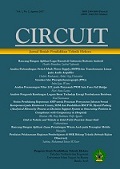Simulasi Alat Photoplethysmograph (PPG)
DOI:
https://doi.org/10.22373/crc.v1i2.2081Keywords:
Heart, Photoplethysmograph (PPG), monitored, online, telemedicineAbstract
Heart is a vital organ in the human body. The heart functions circulated the blood throughout the body. The volume of blood in a body organ will vary due to blood pumping by the heart. Photoplethysmograph (PPG) is a device that can detect changes in blood volume using optical sensors. The purpose of this research is to make Photoplethysmograph monitoring system online. That is a device to monitor blood volume changes and display the change graph. Fluctuations in blood volume changes are influenced by the rhythm of blood pumping by the heart. Each peak on the PPG signal is correlated with one heartbeat. Photoplethysmograph charts can be used to determine the condition and abnormalities of a person's heart. Photoplethysmograph system online is realized in the form of sensors, amplifiers, LPF, ADC, and microcontroller as a serial interface, wiz610wi module, and web applications as online PPG graph viewer. Sensors composed of red LED and photoresistor (LDR) are placed on the fingers. The rays emitted by the LEDs are received by the LDR. The signals received by the LDR vary according to the volume of blood changes. The sensor output signal is then amplified and filtered. Incoming filter output signal ADC, serial interface by AT89C2051 then by wiz610wi module transmitted for display and monitored. Obtained Devices and apps created have worked well. The signal shown is pretty good, clean of noise. Transmission distance measured up to 70 m with delay less than 200 ms. The average heart rate calculation was in error 3%Downloads
Published
2017-11-02
Issue
Section
Articles
License
Authors who publish in this journal agree to the following terms:
- Authors retain copyright and grant the journal right of first publication with the work simultaneously licensed under a Creative Commons Attribution License that allows others to share the work with an acknowledgement of the work's authorship and initial publication in this journal.
The Journal uses license CC-BY-SA or an equivalent license as the optimal license for the publication, distribution, use, and reuse of scholarly works.
Authors are able to enter into separate, additional contractual arrangements for the non-exclusive distribution of the journal's published version of the work (e.g., post it to an institutional repository or publish it in a book), with an acknowledgement of its initial publication in this journal.
- Authors are permitted and encouraged to post their work online (e.g., in institutional repositories or on their website) prior to and during the submission process, as it can lead to productive exchanges, as well as earlier and greater citation of published work (See The Effect of Open Access).

